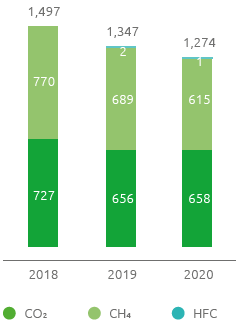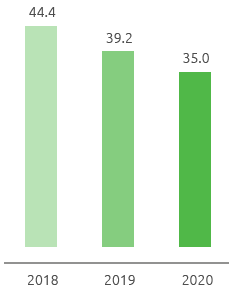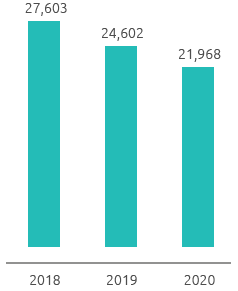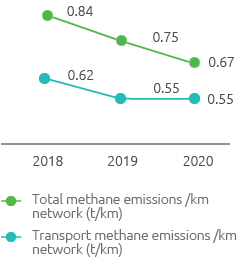Direct GHG emissions (Scope 1)
Total Scope 1 emissions (ktCO2eq)

Snam’s main direct emissions (Scope 1) are methane and carbon dioxide emissions. Methane (CH4) emissions arise from the release of natural gas into the atmosphere, from normal plant operation, from the connection of new gas pipelines and the maintenance activities, or from accidental spills occurring at infrastructures. Emissions of carbon dioxide (CO2) are produced by burning fossil fuels for operational activities. Finally, a negligible part of greenhouse gas emissions comes from the use of hydrofluorocarbons (HFCs) in refrigeration systems.
Direct emissions amounted to approximately 1.27 million tonnes, a clear reduction compared to 2019 (-5%) and 2018 (-15%). CO2 emissions from combustion amounted to approximately 0.66 million tonnes (in line with 2019 and -9% if compared to 2018), while CO2eq emissions deriving from methane and HFC emissions were equal to approximately 0.62 million tonnes and 0.001 million tonnes (-11% compared to 2019 and -20% compared to 2018).
The CO2eq was assessed in accordance with the instructions of the most recent Intergovernmental Panel on Climate Change (IPCC) “Fifth Assessment IPCC Reports” that assigned methane a Global Warming Potential (GWP) of 28.
Natural gas emissions
Natural gas emissions amounted to 35.0 million m3, down 11% compared to 39.2 million m3 in 2019 and 21% compared to 2018, thanks to gas recompression interventions in the line, interventions with tapping machines (technology that allows detaching from operating pipelines for new connections without interrupting service), the use of Leak Detection and Repair (LDAR) technologies and other initiatives to replace network components. All these activities have reduced both total emissions of natural gas and specific methane emissions, avoiding the emission of more than 10 million m3 of natural gas into the atmosphere, equivalent to 183,000 tonnes of CO2eq avoided (+11% compared to 2019). The overall natural gas reduction in 2020 was -30% compared to 2015.
The results were achieved thanks to the numerous activities to monitor and reduce methane emissions. In particular, the LDAR (Leak Detection & Repair) programme, one of the projects to which the Group has committed the most resources, has enabled fugitive emissions to be identified and contained.
Total natural gas emissions (mln m3)

Total CH4 emissions (t)

Methane emissions per km network (t/km)

Snam has also carried out a campaign to measure fugitive emissions at a representative sample of Line Points (plants required for gas transportation and dispatching), updating the emission factors for this type of point, and has completed the campaign to repair leaks at booster and storage plants. These activities resulted in an overall reduction in methane emissions of approximately 1 million m3. In addition, the Group continued the campaign to install ball valves in about 350 plants over three years, leading to a reduction of about 3.87 million m3 in total.
In 2020, Snam has further increased the target for recovery of natural gas emissions during maintenance activities, to 40%, the latter value intended as the average of the last 5 years. As a result of the emission containment activities implemented in the year despite the pandemic, the 2020 figure was 49%, 9 percentage points above the 2021-2023 target and up from the 2019 figure (44%).
The various projects also resulted in a decrease in total methane emissions per kilometre of network (-10% compared to 2019), with a decrease in methane emissions related to transport activity, especially compared to 2018 (-12%).
Snam’s partnerships to reduce methane emissions
Snam has joined specific initiatives in order to monitor methane emissions more effectively and efficiently, as this is the Group’s main type of emission. In addition to joining the Oil and Gas Methane Partnership (OGMP) 2.0, Snam organised the Italian session of the MGP (Methane Guiding Principle), in collaboration with Eni, on reducing natural gas emissions, held at Imperial College London, with the participation, among others, of the main Italian gas distribution companies. In addition, Snam has launched a new research activity within the European Gas Research Group (GERG) on top-down and bottom-up reconciliation methodologies for measuring emissions.